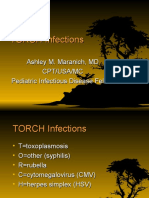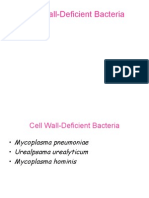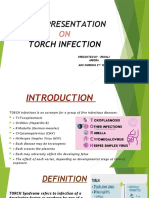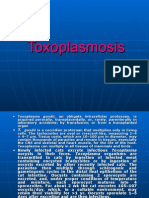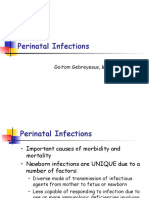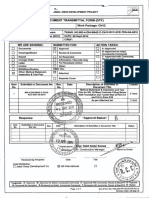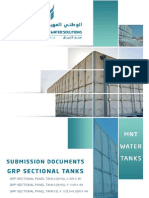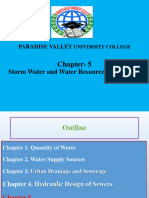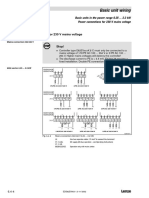Toxoplasmosis in Pregnancy
Toxoplasmosis in Pregnancy
Uploaded by
adibeuutCopyright:
Available Formats
Toxoplasmosis in Pregnancy
Toxoplasmosis in Pregnancy
Uploaded by
adibeuutOriginal Description:
Copyright
Available Formats
Share this document
Did you find this document useful?
Is this content inappropriate?
Copyright:
Available Formats
Toxoplasmosis in Pregnancy
Toxoplasmosis in Pregnancy
Uploaded by
adibeuutCopyright:
Available Formats
TOXOPLASMOSIS IN
PREGNANCY
HM Sulchan Sofoewan
Departement of Obstetrics and
Gynecology Faculty of Medicine
Gadjah Mada University
TOXOPLASMOSIS
Parasitic infection
Caused by protozoa: Toxoplasma Gondii
Toxoplasma Gondii exists oin three forms:
1. Trophozoite/Tachyzoite
2. Tissue cysts/Bradyzoite
3. Oocysts/Sporozoite
FREQUENCY OF TOXOPLASMA
ANTIBODY IN WOMEN IN IND
Year No IgG % pos IgM % pos
1996 568 52,3 12,9
2000 3236 51,3 5,2
2001 8565 53,0 5,4
TOXOPLASMA GONDII
Trophozoite:
Requires in intracellular habitat to survive
and multiply
Reproduction is endogenous
During the acute phase, it invades every
type of cell
After invasion the organisms multiply until
cell cytoplasm is so filled that the cell is
disrupted
TOXOPLASMA GONDII
Tissue cysts:
Formed within the host cells as early as
eight day of an acute infection
Probably persist throughout the life of the
host
Skeleton, heart muscle and brain are the
most common sites for latent infections
TOXOPLASMA GONDII
Oocyst:
Produced in the small intestine of the cat
One shed, the oocyte sporulates in 1 to 5 days
and become infectious
Under appropriate condition it remain infectious
for more than 1 year
The parasite transmitted by direct handling of
contaminated soil and cat feces
All form of parasite are destroyed by adequate
freezing and heating
MATERNAL INFECTION
Transmission of toxoplasma to human occurs
through the ingestion of under-cooked meat
Through other foods contaminated with oocyte,
or by transfusion of whole blood.
Syndrome including: fatigue, malaise, cervical
lymphadenopathy and atypical lymphocytosis
Placental and fetal infection occur during the
spreading phase of the parasitemia
Fetal infection 30-40%, increase with gestational
age
FETAL INFECTION
During 1
st
trim, the rate of transmission is
approximately 15%, the rate of 2
nd
trim is
approximately 30 % and 3
rd
trim is 60 %
Fetal morbidity and mortality rate are higher
after early transmission
Infected neonates often have evidence of
disease: LBW. Hepatosplenomegaly, icterus,
anemia, hydrocephalus, intracranial calcification
Sequelae vision loss, psychomotor and mental
retardation, hearing loss and chorioretinitis
PREVENTION
Primary prevention: information about the
way of infection (cat, raw meet) to avoid
ingestion, inhalation, important for all
pregnant women areseronegative
Secondary prevention: detection of
infected women during pregnancy to start
treatment before fetus gets infected
Tertiary prevention: treatment of infected
children to reduced/avoid symptom
HYGIENIC AND DIETITIC
EDUCATION
There is no vaccine for toxoplasmosis, but many
cases of congenital infection could be prevented
Avoid eating raw or uncooked meat
Wash salads, vegetables, fruits and berries
Have good kitchen hygiene
Avoid contact with cat feces (kittens)
Wash hands after contact with sand and soil
Use gloves when gardening
DIAGNOSIS OF CONGENITAL
TOXOPLASMOSIS
Search for the parasite: seldomly used
Serological test: measure antibodies
Detection of the symptoms:
- prenatal ultrasound
- cranial ultrasound
Amniocentesis: to look for DNA of parasite
by PCR-technique
SEROLOGICAL TEST
Being infected leads to some weeks of
parasitemia, can be passed on to the fetus
The body starts to produced antibodies
They fight againt the parasite, control the
disease, no more parasite circle in blood
Some group of Ig: IgG, IgM, IgA, IgE
For diagnosis of toxoplasmosis usually IgG
dan IgM are measured
Continue
Before happened an infection IgG -, IgM
When an infection happens, IgG +, IgM +
IgM + during acute infection and stay + in limited
time 6 months 1 year
IgG rise during acute infection, sink slowly
again, but stay +, protect against another
parasitemia, protect to the fetus
If stable IgG and no IgM: infection long ago,
protection, latent infection
Early pregnancy and + testing later
seroconversion acute infection
If IgG+ IgM +,infection happened short time ago
SEROLOGICAL TEST
Interpretation of toxoplasmosis serology
results:
IgM IgG Interpratation
+ - Possible acute infection, IgG
titers reassed in several weeks
+ + Possible acute infection
- + Remote infection
- - Susceptible, uninfected
Continue
When fetal infection is diagnosed by
prenatal testing, pyrimethamine,
sulfonamides and folinic acid are added to
spiramycine to eradicate parasites in the
placenta and fetus.
DIAGNOSTIK PRENATAL
Menyadari besarnya dampak toksoplasmosis
kongenital pada janin, bayi serta anak disertai
kebutuhan konfirmasi infeksi janin prenatal pada
ibu hamil, maka para obstetrikus
memperkenalkan metode baru yang merupakan
koreksi atas konsep dasar pengobatan
toksoplasmosis kongenital yg lampau.
Konsep lama hanya bersifat empiris dan
berpedoman pada hasil uji serologis ibu hamil.
Lanjutan
Saat ini pemanfaatan tindakan kordosentesis
dan amniosentisis dengan panduan
ultrasonografi guna memperoleh darah janin
atau cairan ketuban sebagai pendekatan
diagnostik merupakan ciri para obstetrikus pada
dekade 90-an.
Selanjutnya segera dilakukan pemeriksaan
spesifik dan rumit yang sifatnya biomolekuler
atas komponen janin tsb (darah atau air
ketuban) dalam waktu relatif singkat dengan
ketepatan yg tinggi.
Lanjutan
Bahkan diagnostik prenatal dipandang
lebih efektif utk menghindari atau
menekan risiko toksoplasmosis kongenital
karena upaya prevensi primer pada ibu
hamil berupa nasihat menghindari
makanan/minuman yg kurang dimasak
kurang berhasil. Sehingga upaya
diagnostik prenatal disebut sebagai
prevensi sekunder.
AKTIVITAS DIAGNOSIS
PRENATAL
Diagnosos prenatal umumnya dilakukan
pada usia kehamilan 14-27 minggu,
aktivitasnya sbb:
1. Kordosentesis dan amniosentesis
2. Pembiakan darah janin dan air ketuban,
atau inokulasi kedlam ruang peritoneum
tikus, diikuti isolasi parasit.
3. Pemeriksaan PCR utk mengidentifikasi
DNA T.Gondii.
Lanjutan
4. Pemeriksaan dgn tehnik ELISA pada darah
janin guna mendeteksi antibodi IgM dan IgA
janin spesifik (anti toksoplasma).
5. Pemeriksaan tambahan berupa menetapkan
kadar enzim liver, platelet, leukosit (monosit dan
eosinofil) dan limfosit khususnya rasio CD4 dan
CD8
Diagnosis toksoplasmosis kongenital ditegakkan
berdasar hasil pemeriksaan adanya IgM dan IgA
dari darah janin, ditemukan parasit pada kultur
atau inokulasi dan DNA dari T.Gondii pd PCR
darah janin atau air ketuban.
AGAR HASILNYA TERPERCAYA
1. Didahului oleh skrining serologik maternal,
terjadi serokonversi.
2. Ketrampilan klinis melakukan kordosentesis /
amniosentesis
3. Ketrampilan melakukan kultur dan inokulasi,
ELISA dan PCR
4. Diagnosis prenatal berdasar amniosentesis
juga untuk diagnosis infeksi janin kongenital
paling sering digunakan utk Dx infeksi janin
kengenital.
Lanjutan
Amniosentesis dapat dikerjakan sejak
umur kehamilan 14 minggu, kordosentisis
setelah umur kehamilan 20 minggu.
Amniosentesis kurang berbahaya
dibanding kordosentesis karena kurang
invasive.
PCR dg air ketuban sensitifitas 97,4% dan
spesifisitas 100%.
Lanjutan
PCR air ket tunggal sensitifitas 81%, spesifisitas
96%.
Bila inokulasi mencit dikombinasi dg air ket dgn
PCR, sensitifitas 91%.
Untuk pemeriksaan IgM dan IgA spesifik darah
janin sensitifitas berturut-turut 47% dan 38%
Sensitifitas dan spesifisitas IgM spesifik dalam
cairan ketuban adalah 73,3% dan 100%.
Adapun IgM spesifik dlm air ket adalah produksi
janin terinfeksi, karena IgM ibu tidak dapat
melewati barier plasenta.
Lanjutan
Pemeriksaan USG hendaknya dilakukan
dalam diagnosis prenatal untuk mengukur
rasio ventrikel-hemisphere, deteksi
kalsifikasi intrakranial dan adanya asites,
Pemeriksaan USG dianjurkan tiap 3 bulan
sekali sejak diagnosis prenatal.
THANK YOU
You might also like
- Dragon SPSL-HF 4.0 Manual de Servicio PDFDocument222 pagesDragon SPSL-HF 4.0 Manual de Servicio PDFAbraham Elias Sarquis Luna100% (2)
- Cipac MT 187Document4 pagesCipac MT 187Chemist İnanç100% (3)
- Torch InfectionDocument45 pagesTorch InfectionDragos100% (2)
- Toxoplasmosis in PregnancyDocument45 pagesToxoplasmosis in PregnancyTahta PambudiNo ratings yet
- Toxoplasmosis in PregnancyDocument34 pagesToxoplasmosis in PregnancyKahfiyahNo ratings yet
- Torch by DR - AminDocument65 pagesTorch by DR - AminCarkiniNo ratings yet
- TORCH Infection - FergusonDocument24 pagesTORCH Infection - FergusonmehwishNo ratings yet
- Reproductive Tract InfectionsDocument46 pagesReproductive Tract Infectionskb100% (1)
- TORCH in PregnancyDocument63 pagesTORCH in PregnancyKinjal VasavaNo ratings yet
- 13 Parasit 2. Toxoplasma GondiiDocument14 pages13 Parasit 2. Toxoplasma GondiiLABOR BMCNo ratings yet
- Mycoplasma Urea Plasma - 06-07 MedDocument14 pagesMycoplasma Urea Plasma - 06-07 Medapi-3699361No ratings yet
- Pola Imunologi Janin Dalam Kehamilan Dengan Toxoplasmosis: Khairunnisa Abd Rauf A.Zakaria Amien Octo ZulkarnainDocument18 pagesPola Imunologi Janin Dalam Kehamilan Dengan Toxoplasmosis: Khairunnisa Abd Rauf A.Zakaria Amien Octo ZulkarnainArdian Zaka RANo ratings yet
- Sexually Transmitte D Infections: Keeshia Anna Zerrudo Clinical Clerk Iloilo Doctors' Hospital Inc. August 18, 2020Document117 pagesSexually Transmitte D Infections: Keeshia Anna Zerrudo Clinical Clerk Iloilo Doctors' Hospital Inc. August 18, 2020Angela SaldajenoNo ratings yet
- TORCH InfectionsDocument45 pagesTORCH InfectionsteddyporNo ratings yet
- Torch InfectionsDocument27 pagesTorch InfectionsSimi SaiPrasoon100% (1)
- TOXOPLASMADocument14 pagesTOXOPLASMAShanu KumariNo ratings yet
- Infections of Fetus and NewbornDocument78 pagesInfections of Fetus and Newbornnicu.aiims24No ratings yet
- Sexually Transmitted Diseases : (Gonorrhea, Syphilis & Aids)Document54 pagesSexually Transmitted Diseases : (Gonorrhea, Syphilis & Aids)joel david knda mjNo ratings yet
- TORCHDocument31 pagesTORCHRupali Arora100% (4)
- TORCH InfectionsDocument40 pagesTORCH Infectionsyounas63No ratings yet
- 8.. Acute Pelvic Inflammatory DiseasesDocument49 pages8.. Acute Pelvic Inflammatory Diseasesakramdoc1982No ratings yet
- Neonatal SepsisDocument51 pagesNeonatal SepsisAngelo Del VentoNo ratings yet
- Neonatal Sepsis NotesDocument25 pagesNeonatal Sepsis Notesjmugi22No ratings yet
- Toxoplasma TropmedDocument27 pagesToxoplasma TropmedDickyNo ratings yet
- 3.torch InfectionsDocument15 pages3.torch InfectionsKuleshwar SahuNo ratings yet
- Neonatal Sepsis DR JD-1Document30 pagesNeonatal Sepsis DR JD-1mctime35No ratings yet
- Pprom 1 1Document20 pagesPprom 1 1Tehreem AzharNo ratings yet
- ToxoplasmosisDocument12 pagesToxoplasmosisaltabeb hasoon100% (2)
- Torch: Diana Khoirun Nida - 1710211042Document34 pagesTorch: Diana Khoirun Nida - 1710211042Diana Khoirun NidaNo ratings yet
- 4 ToxoplasmoseDocument21 pages4 Toxoplasmosendeyembaye901No ratings yet
- Neonatal InfectionDocument56 pagesNeonatal InfectionajengdwintaNo ratings yet
- PurperalinfectionsDocument128 pagesPurperalinfectionsNathalina DeepikaNo ratings yet
- Sexually Transmitted Infections COLORDocument61 pagesSexually Transmitted Infections COLORWisher Pge100% (1)
- Evaluation and Treatment of Fetal Exposure To Toxoplasmosis 2015Document6 pagesEvaluation and Treatment of Fetal Exposure To Toxoplasmosis 2015Khalila DiantiNo ratings yet
- Neonatal Infection: Julniar M Tasli Herman Bermawi Afifa RamadantiDocument56 pagesNeonatal Infection: Julniar M Tasli Herman Bermawi Afifa RamadantiOtchi Pudtrie WijayaNo ratings yet
- TOXOPLASMOSIS: Diagnosis, Treatment and Prevention in Congenitally Exposed InfantsDocument30 pagesTOXOPLASMOSIS: Diagnosis, Treatment and Prevention in Congenitally Exposed InfantshwelpNo ratings yet
- Neonatal SepsisDocument25 pagesNeonatal Sepsisrfhrz6kpddNo ratings yet
- Infections ViralesDocument8 pagesInfections ViralesGiovani AndemeNo ratings yet
- Wa0017.Document55 pagesWa0017.Noor SeckamNo ratings yet
- Toxoplasma y Citomehalovirus PDFDocument12 pagesToxoplasma y Citomehalovirus PDFGUSTAVO ANDRES NORENA LOPEZNo ratings yet
- Sexually Transmitted Infections and PregnancyDocument19 pagesSexually Transmitted Infections and PregnancyBeyins TiuNo ratings yet
- PeriNatal InfectionsDocument24 pagesPeriNatal InfectionsTadesse MuhammedNo ratings yet
- Human Immunodeficiency Virus (Hiv) : Presenter-Dr. Shasidhar ReddyDocument81 pagesHuman Immunodeficiency Virus (Hiv) : Presenter-Dr. Shasidhar ReddyshravaniNo ratings yet
- UTI - Internship PresentationDocument27 pagesUTI - Internship PresentationPernel Jose Alam MicuboNo ratings yet
- Congenital Infections 1Document37 pagesCongenital Infections 1rahuldhodapkarNo ratings yet
- Group B Streptococcus in Pregnancy and NewbornDocument51 pagesGroup B Streptococcus in Pregnancy and Newbornchandani pandeyNo ratings yet
- Monkeypox in Pregnancy - Dr. Lingga, SP - OGDocument20 pagesMonkeypox in Pregnancy - Dr. Lingga, SP - OGIndah KaDeNo ratings yet
- Genital Tract Infections, TSS,PID (2)Document33 pagesGenital Tract Infections, TSS,PID (2)9s8fjxwhsfNo ratings yet
- Puerperal SepsisDocument4 pagesPuerperal SepsisSonali NayakNo ratings yet
- STDsDocument39 pagesSTDsMukund ChauhanNo ratings yet
- MicrobiologyDocument6 pagesMicrobiologyDerek AtienzaNo ratings yet
- Muhimbili University of Health and Allied Sciences School of NursingDocument42 pagesMuhimbili University of Health and Allied Sciences School of NursingShahid KhanNo ratings yet
- Communicable Diseases Affecting The Reproductive SystemDocument49 pagesCommunicable Diseases Affecting The Reproductive SystemJR Rolf NeuqeletNo ratings yet
- By Intern Dr. Borhan UddinDocument12 pagesBy Intern Dr. Borhan UddinmanjuNo ratings yet
- Congenital ToxoplasmosisDocument64 pagesCongenital ToxoplasmosisFadila R. Lubis LubisNo ratings yet
- Congenital ToxoplasmosisDocument26 pagesCongenital ToxoplasmosisMichael WijayaNo ratings yet
- 12 NEONATAL SEPSIS Edit-1Document33 pages12 NEONATAL SEPSIS Edit-1Ibrahim BerhmadNo ratings yet
- Common Complications of PregnancyDocument34 pagesCommon Complications of PregnancyiwennieNo ratings yet
- Ureaplasma Infection, A Simple Guide To The Condition, Diagnosis, Treatment And Related ConditionsFrom EverandUreaplasma Infection, A Simple Guide To The Condition, Diagnosis, Treatment And Related ConditionsNo ratings yet
- A Simple Guide to Sexually Transmitted DiseasesFrom EverandA Simple Guide to Sexually Transmitted DiseasesRating: 5 out of 5 stars5/5 (11)
- Guide to Pediatric Urology and Surgery in Clinical PracticeFrom EverandGuide to Pediatric Urology and Surgery in Clinical PracticeNo ratings yet
- Game Cards Helps Dyscalculia To Understand The Addition Concepts PDFDocument8 pagesGame Cards Helps Dyscalculia To Understand The Addition Concepts PDFPpki Smk Yaacob LatifNo ratings yet
- BK91-1310-CPF-999-PIP-DPS-0001 - 0 - Pipe Support Specification and Drawings - C1Document81 pagesBK91-1310-CPF-999-PIP-DPS-0001 - 0 - Pipe Support Specification and Drawings - C1Panneer SelvamNo ratings yet
- MICRORDDocument9 pagesMICRORDalexanderNo ratings yet
- Traditional Courtyard Houses As A Model For Sustainab - 2017 - Frontiers of ArchDocument17 pagesTraditional Courtyard Houses As A Model For Sustainab - 2017 - Frontiers of ArchMj ShobanaNo ratings yet
- Speech Act and Communicative StrategyDocument19 pagesSpeech Act and Communicative StrategyCheinalyn MacatubalNo ratings yet
- Theoretical Issues in Contrastive Linguistics - (CONTRASTILE ANALYSIS AND THE MODERN THEORY OF LANGUAGE)Document58 pagesTheoretical Issues in Contrastive Linguistics - (CONTRASTILE ANALYSIS AND THE MODERN THEORY OF LANGUAGE)felixdelacruzz2021No ratings yet
- 21 Essential Warehouse KPIs To Measure Warehouse Performance and EfficiencyDocument8 pages21 Essential Warehouse KPIs To Measure Warehouse Performance and Efficiencysunnysam.8419No ratings yet
- Probability Stat Exercises 2022 - PRINTDocument41 pagesProbability Stat Exercises 2022 - PRINTNguyen Ngoc Diem SuongNo ratings yet
- TRN 0515 B PDFDocument15 pagesTRN 0515 B PDFrayNo ratings yet
- s1166501305921 PDFDocument8 pagess1166501305921 PDFRaj RajeshNo ratings yet
- Material Submittal - GRP Sectional Panel TanksDocument204 pagesMaterial Submittal - GRP Sectional Panel Tanksmohamed kamalNo ratings yet
- Chapter 5 DrainageDocument22 pagesChapter 5 DrainagenathanzdarikelozayiNo ratings yet
- Underwater Image Dehazing Using A Novel Color Channel Based Dual Transmission Map EstimationDocument24 pagesUnderwater Image Dehazing Using A Novel Color Channel Based Dual Transmission Map Estimationpranjali singhNo ratings yet
- NHS FPX 5004 Assessment 2 Leadership and Group CollaborationDocument5 pagesNHS FPX 5004 Assessment 2 Leadership and Group Collaborationjoohnsmith070No ratings yet
- Terminale 8200 - VectorDocument1 pageTerminale 8200 - VectorVasile TipcuNo ratings yet
- Seasonal Migration and Children'S Vulnerability: Case of Brick Kiln Migration From Ranchi DistrictDocument12 pagesSeasonal Migration and Children'S Vulnerability: Case of Brick Kiln Migration From Ranchi Districtsid.samir2203No ratings yet
- Journal of Economic, Administrative and Legal Sciences مولعلا ةلجم ا ةيداصتقلا ةيرادلإاو ةينوناقلاوDocument25 pagesJournal of Economic, Administrative and Legal Sciences مولعلا ةلجم ا ةيداصتقلا ةيرادلإاو ةينوناقلاوHussainNo ratings yet
- (已压缩)SANJIANG Fire Alarm Brochure.2023Document11 pages(已压缩)SANJIANG Fire Alarm Brochure.2023许浩江No ratings yet
- Hum1 ReviewerDocument3 pagesHum1 ReviewerPrincess Joy LucasNo ratings yet
- Organic ElectronicsDocument6 pagesOrganic ElectronicspromzgNo ratings yet
- AIATS - JEE (A) 2024 - Test-4A - P-2 - (Code-B) - Ph-3 & 4 - 02-04-2023 - SOLDocument11 pagesAIATS - JEE (A) 2024 - Test-4A - P-2 - (Code-B) - Ph-3 & 4 - 02-04-2023 - SOLsleepingpal2No ratings yet
- Group 8 IBC06Document4 pagesGroup 8 IBC06vuducanhcfglNo ratings yet
- My Quest For BeautyDocument3 pagesMy Quest For BeautyPaul SchumannNo ratings yet
- Lab 1Document4 pagesLab 1Muhammad TehreemNo ratings yet
- Historia - de - La - Psicolog - A - 1a - Ed - Capitulo Tres.Document12 pagesHistoria - de - La - Psicolog - A - 1a - Ed - Capitulo Tres.Xiomy PasajeNo ratings yet
- Semi-Detailed Lesson Plan/Science 1: Mayapyap Elementary SchoolDocument5 pagesSemi-Detailed Lesson Plan/Science 1: Mayapyap Elementary SchoolSofia Alexa CuchapinNo ratings yet
- Brain PacticityDocument37 pagesBrain Pacticitykobe202160No ratings yet
- Experiment 3: Neutralization Capacity of Commercial Antacid AcidDocument10 pagesExperiment 3: Neutralization Capacity of Commercial Antacid AcidfizaNo ratings yet


